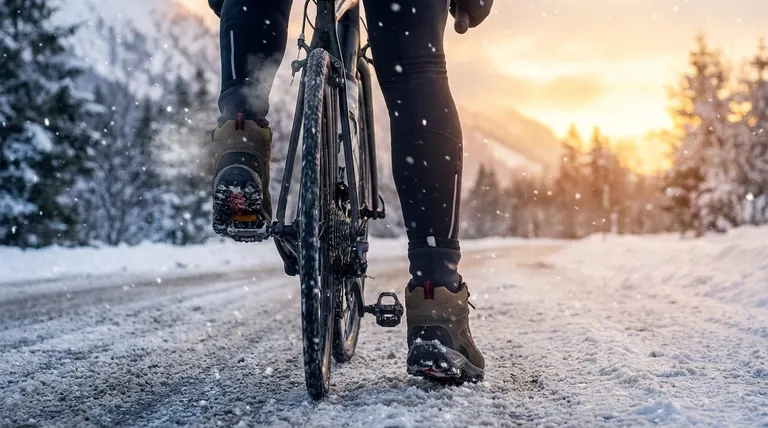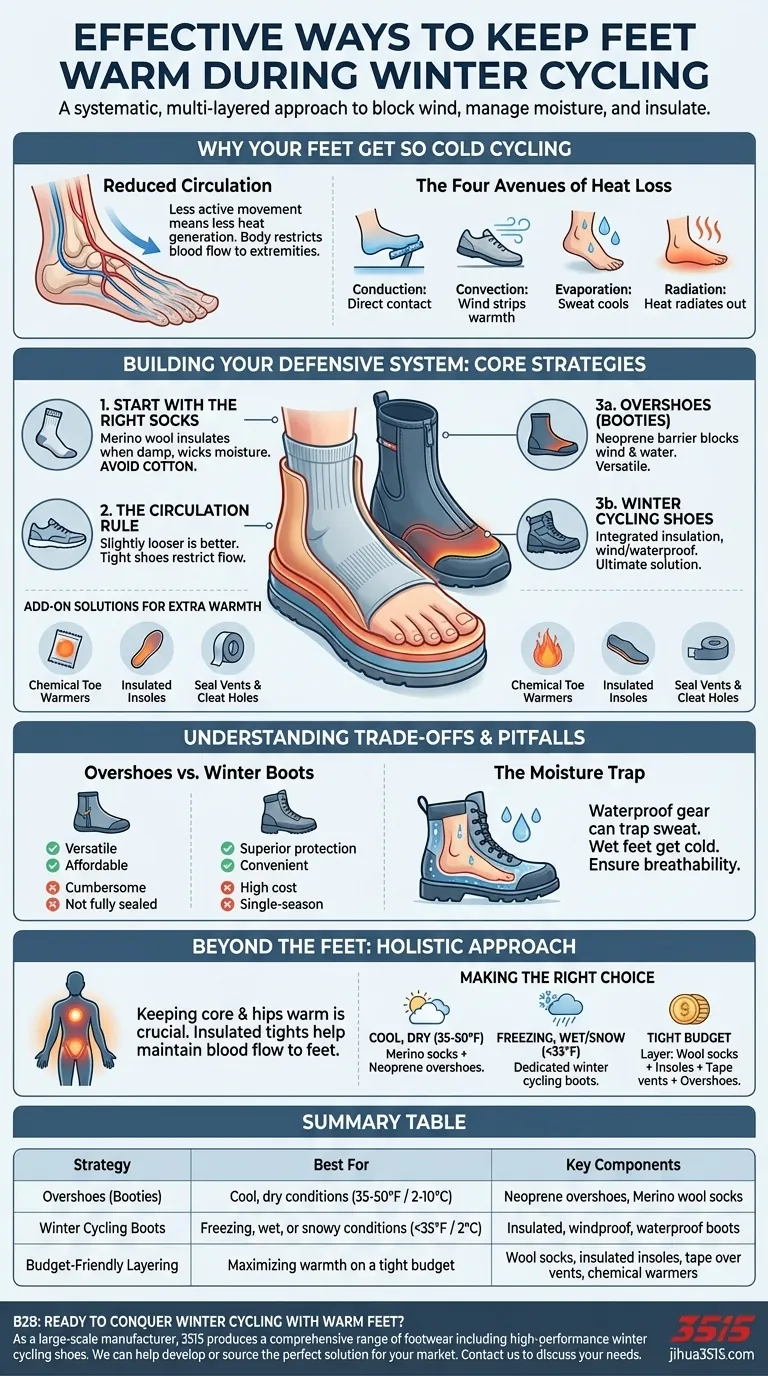To effectively keep your feet warm during winter cycling, you must create a multi-layered system that blocks wind, manages moisture, and insulates against heat loss. The most common and reliable solutions involve combining wool socks with either thermal overshoes (booties) that cover your existing shoes or investing in dedicated winter-specific cycling boots.
The core challenge isn't just about adding warmth; it's about defending your feet from external cold and internal moisture. A successful strategy requires a systematic approach to insulation, wind-proofing, and water management, starting from your skin and working outwards.

Why Your Feet Get So Cold Cycling
Understanding the root cause is the first step to finding the right solution. Unlike running or walking, cycling involves less active foot movement, which means your feet generate significantly less heat on their own.
The Problem of Reduced Circulation
Your body's natural response to cold is to restrict blood flow to your extremities—hands and feet—to protect your vital core organs. This self-preservation instinct means your feet receive less warm blood, making them the first to suffer.
The Four Avenues of Heat Loss
Your feet are under constant attack from four types of heat loss:
- Conduction: Direct contact with cold pedals and cleats sucks heat away.
- Convection: Cold wind whipping across your shoes strips warmth rapidly.
- Evaporation: Sweat cools you down, which is disastrous when it's already cold.
- Radiation: Your feet radiate their own heat out into the cold air.
Building Your Defensive System: Core Strategies
An effective setup is a system of components working together. You can mix and match these strategies based on the temperature and your budget.
Start with the Right Socks
Your socks are the foundation. Choose merino wool, which insulates even when damp and effectively wicks moisture away from your skin.
Avoid cotton at all costs, as it holds moisture against your skin. For very cold days, you can layer a thin silk or synthetic liner sock under a medium-weight wool sock, but be cautious.
The Circulation Rule
Your layers should never be so thick that they make your shoes tight. Restricted circulation from tight shoes will make your feet colder, no matter how much insulation you have. If you have to choose, slightly looser is always better.
Block the Elements: Overshoes (Booties)
Overshoes, or "booties," are covers that fit over your regular cycling shoes. They are an excellent and versatile solution.
Most are made from neoprene, the same material used in wetsuits. They provide a powerful thermal barrier, block wind entirely, and offer significant water resistance. For varying temperatures, you can layer a thin bootie with a thicker one.
The Ultimate Solution: Winter Cycling Shoes
For dedicated winter cyclists, winter-specific cycling shoes are the most effective solution. These are integrated boots with built-in insulation, a windproof and waterproof outer membrane, and a higher cuff to seal out drafts.
While they are a significant investment, they offer superior warmth and comfort without the bulk of layering multiple overshoes.
Add-on Solutions for Extra Warmth
For deep-winter conditions or to boost a budget-friendly setup, consider these additions:
- Chemical Toe Warmers: These adhesive packets provide several hours of consistent heat when placed on top of your socks.
- Insulated Insoles: Replacing your standard insole with a thermal or wool version helps fight conductive heat loss through the sole of your shoe.
- Seal Vents and Cleat Holes: Many cycling shoes have ventilation holes. Covering these with durable tape (like duct tape) from the inside or outside can dramatically reduce convective heat loss. A small dab of silicone in the cleat bolt holes can also help.
Understanding the Trade-offs and Pitfalls
Every solution has its pros and cons. Objectivity is key to finding what works for you.
Overshoes vs. Winter Boots
Overshoes are more versatile and affordable, allowing you to adapt your favorite summer shoes for three-season use. However, they can be cumbersome to put on and are not as seamlessly sealed as a dedicated boot.
Winter boots offer superior, integrated protection and are far more convenient for daily use. The downside is their high cost and single-season purpose.
The Moisture Trap: A Critical Pitfall
Waterproof gear can be a double-edged sword. While it blocks external water from rain and snow, it can also trap sweat inside.
Wet feet, whether from sweat or snow, will get cold. If you find your feet are sweating heavily inside waterproof boots or socks, you may need a more breathable sock solution to manage that internal moisture.
Beyond the Feet: A Holistic Approach
Surprisingly, keeping your core and hips warm is crucial for warm feet. When your core temperature drops, your body reduces blood flow to your feet.
Ensuring you have insulated tights or pants helps keep the blood circulating to your lower extremities warmer, providing a significant and often overlooked benefit to your feet.
Making the Right Choice for Your Goal
Select your strategy based on your specific riding conditions and commitment.
- If your primary focus is riding in cool, dry conditions (35-50°F / 2-10°C): Start with merino wool socks and a quality pair of neoprene overshoes over your regular cycling shoes.
- If your primary focus is committed riding in freezing, wet, or snowy conditions (below 35°F / 2°C): Investing in dedicated winter cycling boots will provide the most reliable warmth and comfort.
- If your primary focus is maximizing warmth on a tight budget: Combine layers—use insulated insoles, wool socks, tape over your shoe vents, and add thick overshoes.
Ultimately, preventing cold feet is about creating a deliberate barrier against the elements so you can enjoy riding in any season.
Summary Table:
| Strategy | Best For | Key Components |
|---|---|---|
| Overshoes (Booties) | Cool, dry conditions (35-50°F / 2-10°C) | Neoprene overshoes, Merino wool socks |
| Winter Cycling Boots | Freezing, wet, or snowy conditions (<35°F / 2°C) | Insulated, windproof, waterproof boots |
| Budget-Friendly Layering | Maximizing warmth on a tight budget | Wool socks, insulated insoles, tape over vents, chemical warmers |
Ready to conquer winter cycling with warm, comfortable feet?
As a large-scale manufacturer, 3515 produces a comprehensive range of footwear for distributors, brand owners, and bulk clients. Our production capabilities encompass all types of shoes and boots, including high-performance winter cycling footwear designed with advanced insulation, windproof membranes, and moisture-wicking materials.
We can help you develop or source the perfect winter cycling shoe solution for your market. Contact us today to discuss your needs and discover how we can bring value to your product line.
Visual Guide

Related Products
- Safety Footwear Wholesale Manufacturer for Custom OEM/ODM Production
- Premium Insulated Safety Boots and Shoes for Wholesale & Bulk Orders
- Premium Suede Sport Safety Shoes for Wholesale & Bulk Orders
- Wholesale Premium Waterproof Nubuck Safety Shoes Boots
- Durable Waterproof Rain Boots | Custom Manufacturer for Wholesale & Brands
People Also Ask
- What are the differences between steel toe, composite toe, and alloy toe Wellington boots? Choose the Right Safety Toe for Your Job
- How long can you wear safety boots? The Lifespan is Determined by Wear, Not Time
- Do snake bite boots work? Your Ultimate Guide to Effective Snake Bite Protection
- What are the cultural perspectives on wearing shoes in the house? A Guide to Home Etiquette & Hygiene
- Is safety-toe as good as steel toe? Choose the Right Protection for Your Job



















